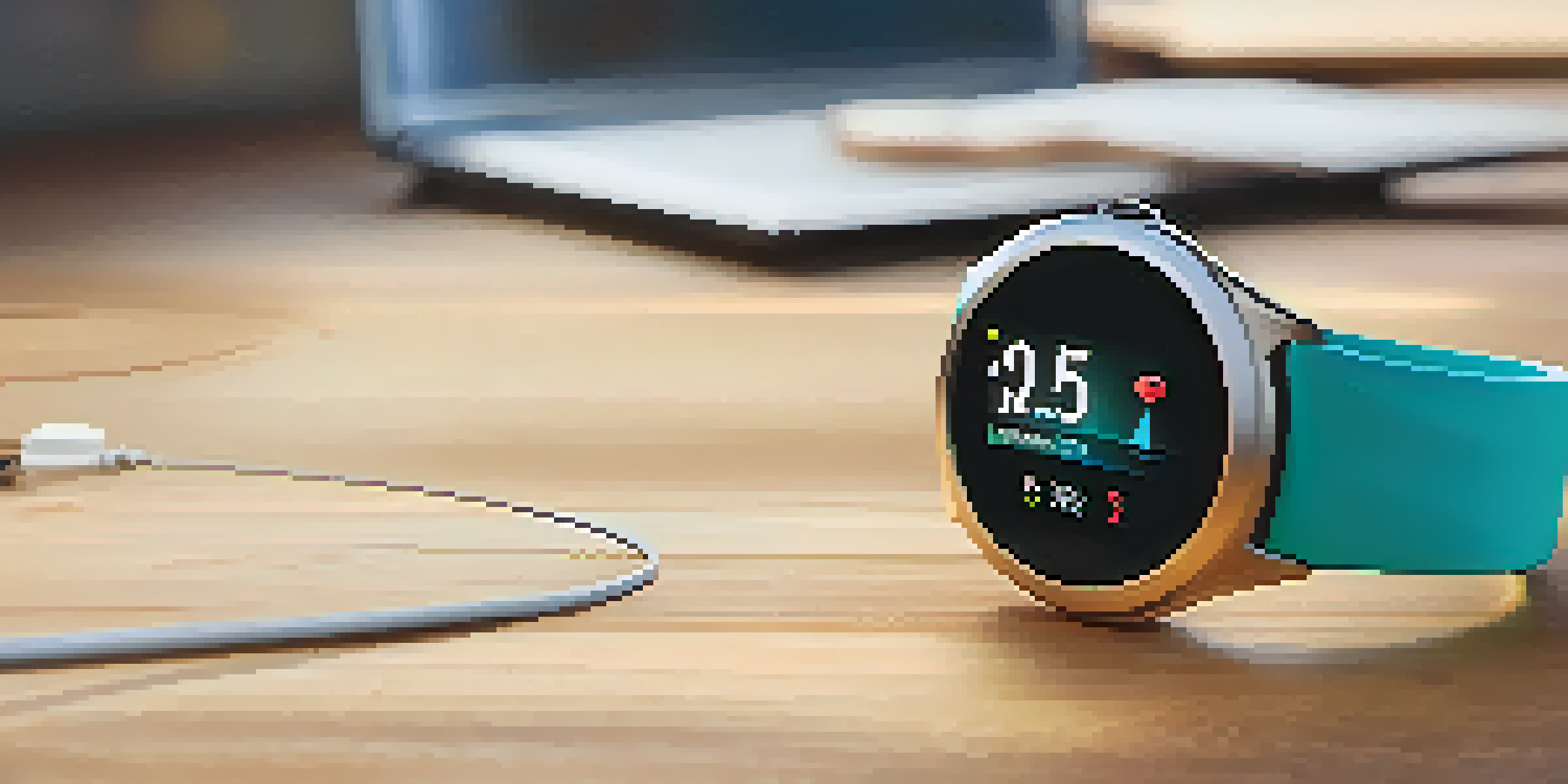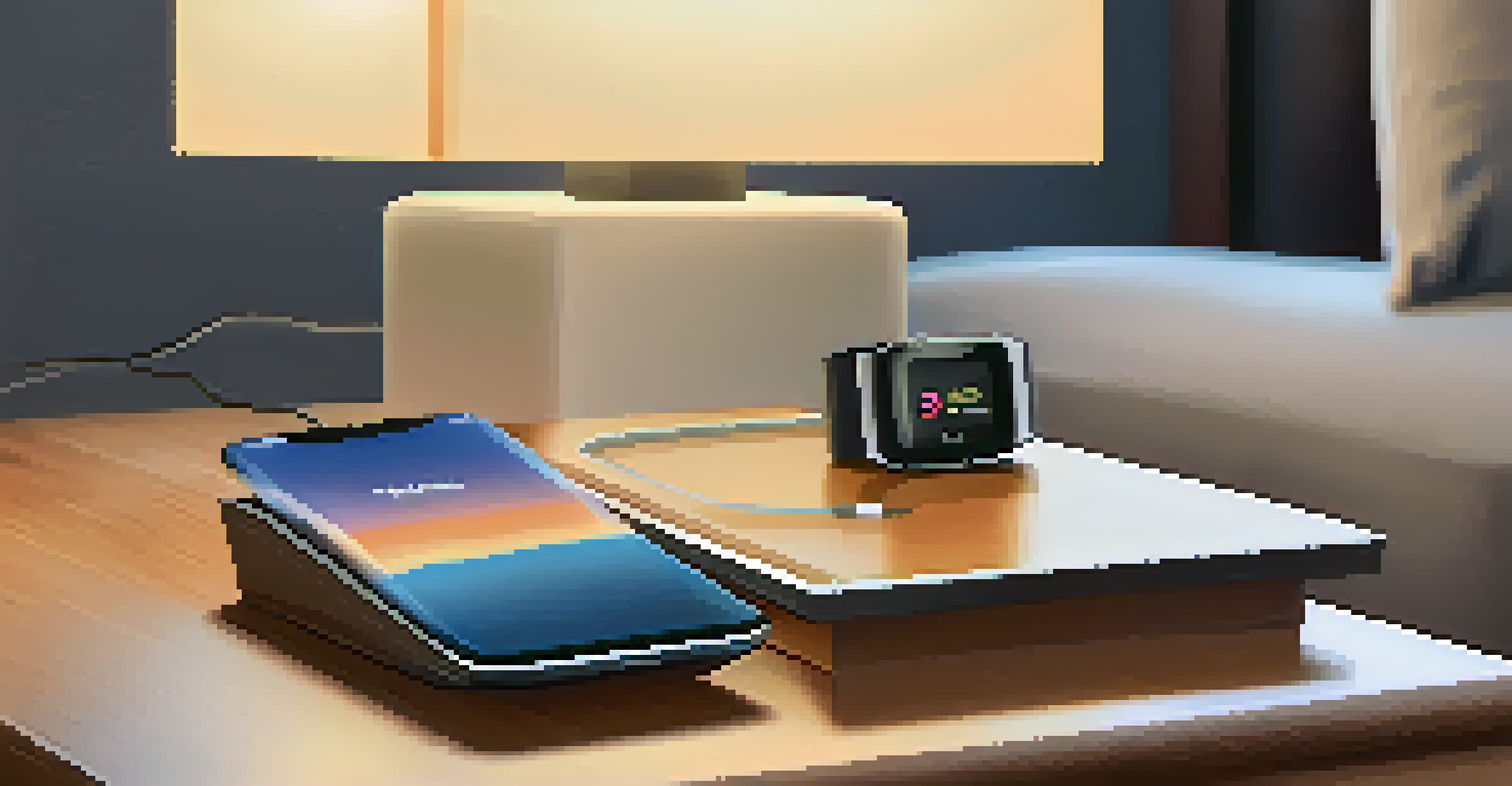Wearable Tech: Bridging the Gap Between Fitness and Health

Understanding Wearable Technology in Fitness and Health
Wearable technology has revolutionized how we approach fitness and health. These devices, from smartwatches to fitness trackers, are designed to monitor various health metrics, making them invaluable tools for both fitness enthusiasts and casual users. Imagine having a coach on your wrist, providing real-time updates on your heart rate, steps taken, and even sleep patterns.
Wearable technology is not just about tracking fitness; it's about empowering individuals to take control of their health.
The integration of technology into these wearables allows users to visualize their health data easily. With just a glance, you can access vital information that helps you make informed decisions about your physical activity and overall well-being. This immediate access to data can motivate users to push harder in their workouts or take a break when necessary.
Moreover, wearables often connect to apps that provide deeper insights and tailored recommendations. This connectivity bridges the gap between fitness and health, making it easier for individuals to achieve their goals while ensuring they are not overexerting themselves. In essence, these devices empower users to take charge of their health in a more informed way.
How Wearables Track Fitness Activities Effectively
Fitness trackers are equipped with sensors that monitor various physical activities, from walking and running to cycling and swimming. These devices can count steps, measure distance, and even analyze your exercise form, providing you with comprehensive data on your performance. This detailed feedback can help you refine your workouts for better results.

For instance, a runner might use a smartwatch to track their pace and distance. By reviewing this data post-run, they can identify areas for improvement and set more precise goals for future training sessions. It's like having a personal trainer who never leaves your side, offering insights that can take your fitness journey to the next level.
Wearables Enhance Health Awareness
Wearable technology empowers users by providing real-time health metrics, enabling informed decisions about fitness and well-being.
Moreover, some wearables can detect your heart rate variability, providing insights into your cardiovascular health during workouts. This means you can ensure you’re training within the optimal heart rate zone, maximizing your fitness benefits while minimizing the risk of injury. It’s all about smart training, guided by data.
Bridging Health Monitoring with Fitness Tracking
Wearable tech doesn't just stop at tracking fitness; it's also a powerful tool for health monitoring. Many devices now include features that track heart rate, blood pressure, and even blood oxygen levels. This ability to monitor vital signs helps users stay aware of their health status, particularly if they have existing medical conditions.
Data is the new oil, and wearable technology provides the refinery to turn that data into actionable insights for health and fitness.
For example, individuals with heart issues can greatly benefit from wearables that alert them to abnormal heart rates during exercise. This real-time feedback can be life-saving, allowing users to adjust their activity levels based on their heart health. It's a proactive approach to fitness that prioritizes safety.
Additionally, the data collected can be shared with healthcare providers, fostering a collaborative approach to health management. Imagine your doctor receiving regular updates about your activity levels and heart rate; this information can guide more personalized care and recommendations. Wearables are truly bridging the gap between fitness and health, creating a holistic view of well-being.
The Role of Data Analytics in Wearable Tech
Data analytics plays a critical role in wearable technology, transforming raw data into actionable insights. These devices collect vast amounts of information about your daily activities and health metrics, but it’s the analysis that brings value. By interpreting this data, wearables can provide personalized tips that enhance your fitness and health journey.
For instance, if your tracker notices a decline in your activity levels, it might send you a reminder or a motivational message to get moving. This kind of proactive engagement keeps users motivated and accountable, ensuring they stay on track with their fitness goals. It’s like having a friendly nudge when you need it most.
Data Analytics Drives Engagement
Through data analytics, wearables offer personalized insights and reminders that help users stay motivated and accountable in their fitness journeys.
Moreover, many wearables offer predictive analytics, which can forecast future health issues based on current data trends. This capability allows users to take preventive measures, like adjusting workout intensity or consulting with a doctor if necessary. By harnessing the power of data, wearables are not just tools; they're partners in health management.
Challenges and Limitations of Wearable Technology
While wearable technology offers numerous benefits, it’s essential to acknowledge its challenges and limitations. One significant concern is data accuracy; not all devices provide precise readings, which can lead to misinformation about your health and fitness. For example, a heart rate reading might vary significantly between devices, leaving users confused about their actual condition.
Another challenge is the potential for information overload. With so much data at our fingertips, users may feel overwhelmed by the sheer volume of metrics to track. It's easy to get caught up in the numbers, losing sight of the overall goal of improving health and fitness. Finding a balance is crucial.
Lastly, privacy concerns surrounding health data are ever-present. Users must be cautious about where their information is stored and how it’s used. Ensuring that wearable tech companies prioritize data security is vital for building trust and encouraging users to engage with these devices fully.
The Future of Wearable Technology in Health and Fitness
As technology continues to evolve, the future of wearable tech in health and fitness looks promising. We can expect advancements in sensor technology, making devices even more accurate and comprehensive in tracking health metrics. Imagine a future where wearables can provide instant feedback on hydration levels or even detect early signs of illness through biometric changes.
Additionally, increased integration with other smart devices will enhance the user experience. Picture your wearable syncing seamlessly with your smart home system, adjusting your environment based on your activity levels or sleep patterns. This interconnectedness will create a more holistic health management system that caters to individual needs.
Choose the Right Device for You
Selecting the right wearable involves understanding your fitness goals, desired features, and ensuring comfort for regular use.
Finally, as more research emerges on the benefits of wearables, we may see increased adoption among healthcare professionals. This shift could lead to more personalized treatment plans, allowing individuals to proactively manage their health. The future of wearable tech is not just about fitness; it’s about empowering individuals to take control of their health journey.
Choosing the Right Wearable Tech for You
With a plethora of wearable devices on the market, choosing the right one can feel overwhelming. Start by identifying your primary goals—are you focused on fitness tracking, health monitoring, or a combination of both? Knowing your priorities will help guide your decision-making process.
Once you've established your goals, consider the features that matter most to you. For example, if heart rate monitoring is essential, look for devices known for their accuracy in that area. Additionally, assess the compatibility of the device with your smartphone or other tech; seamless integration can enhance your overall user experience.

Lastly, don’t overlook comfort and style. A wearable that you find aesthetically pleasing and comfortable will encourage regular use. After all, the best device is one that fits seamlessly into your life, empowering you to stay active and engaged in your health journey.